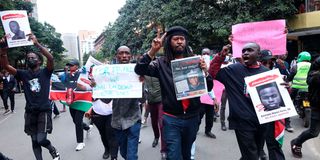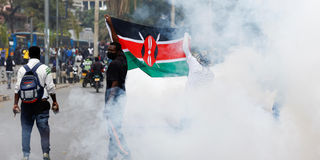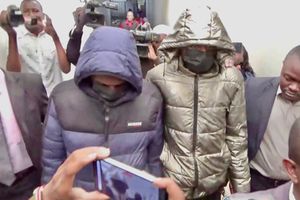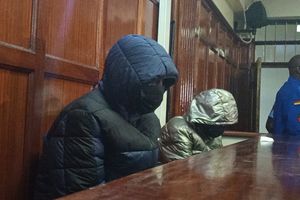
Members of the public protests in Nairobi on June 17, 2025 demanding justice for blogger Albert Ojwang who was killed in police custody at Nairobi’s Central Police Station.
On a day filled with tear gas, flying stones and sirens echoing through the Nairobi Central Business District (CBD), a different kind of formation took shape. As protesters were attacked by armed goons, a group of boda boda riders, members of the Nairobi CBD Riders Association stepped forward and formed a protective ring around demonstrators waving the national flag.
They weren’t part of any organised protest group. They hadn’t been called upon. But in that moment, they chose to act not as bystanders, but as defenders of a shared cause. They stood firm while chaos unfolded around them.
That day, they likely didn’t earn a single cent, but what they offered was more valuable: solidarity. It was a striking image, and for many, an emotional one, a reminder that this moment belongs to all of us.
Their show of support didn’t end there. In a rare public statement, the Nairobi CBD Riders Association officially condemned the violence, distancing themselves from the attacks and making it clear they would not be used to harm fellow citizens.
For many, it was the first time they had seen the association issue any kind of political stance. That’s how extraordinary this moment was. They told the attackers that the violence wasn’t just hurting individuals; it was damaging the trust, safety, and reputation of the everyday working people who keep the city running.
These riders, usually overlooked or stereotyped, became unexpected protectors. Their role in that moment redefined what community defence can look like in times of crisis.
In times of national upheaval, affirmation from respected institutions — churches, professional associations, and cultural figures can carry life-saving moral weight.
Gen Z protests
For the young Kenyans leading the Gen Z protests against police brutality and government repression, public statements of support have not felt like routine press releases. They’ve felt like lifelines. They have broken through the political noise and offered something more powerful than policy: acknowledgement.
When CITAM issued its statement condemning the violence, it was quickly followed by declarations from the Anglican Church, the Catholic bishops, and the Presbyterian Church of East Africa. While these religious bodies are often cautious in their political messaging, their tone this time was unmistakable: the violence, the repression, the killings, all of it was wrong. Their words were measured, but their meaning was clear. For a generation frequently dismissed as disorderly or emotional, hearing the country’s moral authorities affirm their struggle meant everything.

People hold a Kenyan flag during a demonstration over the death of Kenyan blogger Albert Ojwang in police custody, in downtown Nairobi, Kenya, June 17, 2025.
These were not just words of comfort. They were a signal that the pain, the anger, the defiance, it was all justified. It was real. The fact that these churches chose to speak out not months later, but during the height of unrest was itself a statement.
Religious institutions often exist in a delicate balancing act between faith and power. That they chose to risk political backlash to publicly condemn injustice shows just how loud this movement has become. It’s not just protestors calling for change; it’s the very institutions once considered silent or neutral.
And then there was Jamia Mosque. As police chased protesters through city streets and unleashed teargas into crowds, the mosque opened its doors. Inside, people found refuge. It wasn’t a symbolic gesture, it was a concrete act of protection.
Reports later emerged that the mosque had faced pressure from authorities to stay neutral, to stay silent. But they didn’t. They stood by the people. They chose compassion over compliance. In that act, they reminded the nation what moral leadership looks like when it’s tested. Not just in statements, but in choices. In shelter. In defiance. In courage.
What happened at Jamia Mosque was historic. In a city centre gripped by fear, where businesses were closing and people were fleeing for safety, this sacred space did what the government would not: protect its people. In doing so, it joined the ranks of those whose solidarity will not be forgotten when the dust settles. It’s one thing to post a message of peace online. It’s another to open your doors when it’s dangerous to do so.
Public figures
Artistes and public figures also began to raise their voices. When dancehall artist Konshens shared the chilling video of Klinzy Masinde, the officer accused of shooting hawker Boniface Kariuki, it reverberated across platforms. The footage, showing an unarmed man being gunned down at close range, needed no commentary.

A man displays a placard with the picture of Deputy Inspector-General of Police Eliud Lagat during protests in Nairobi on June 12, 2025 to demand justice for Albert Ojwang who died in police custody.
Konshens simply posted the video with a clear stance: this is wrong. In a media landscape where silence is often safer, that choice to speak carried weight.
And this kind of visibility matters. When high-profile voices echo the cries from the street, it amplifies them. It gives international weight to what many in power would prefer to dismiss as local chaos. It tells the world and the powers that be that the violence is being watched. That the victims have witnesses. That the people will not be forgotten.
In a country where official responses often gaslight citizens telling us we misunderstood, that we are exaggerating, any act of recognition becomes a form of resistance. Being seen matters. Being heard matters.
In moments like this, it’s not just the violence we remember, but the hands that reached out when we were falling.
These moments of solidarity, whether in statements or actions are not incidental. They are essential. When the dust settles, when headlines move on, what will remain are the relationships built-in resistance. We will remember who stood up, who offered shelter, who livestreamed as they ran. We’ll remember the churches that opened their doors. The riders who blocked the goons. The mosque that lets us breathe.
None of these institutions saved us. We saved ourselves. But their presence mattered. Their words mattered. They reminded us we are not alone. They reminded us that even in a country where silence is safer, some still choose to speak and to act.
In every march, every chant, every hand raised in protest, there is a question hanging in the air: Does anyone see us?
And every time someone answers, “We do,” we take one step closer to a country that sees us all.







